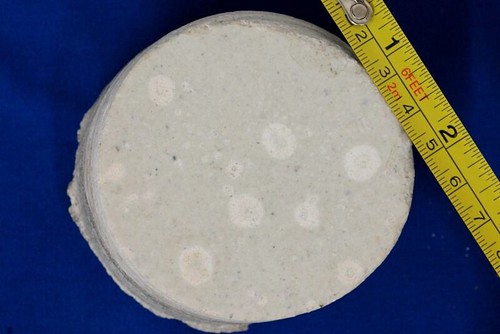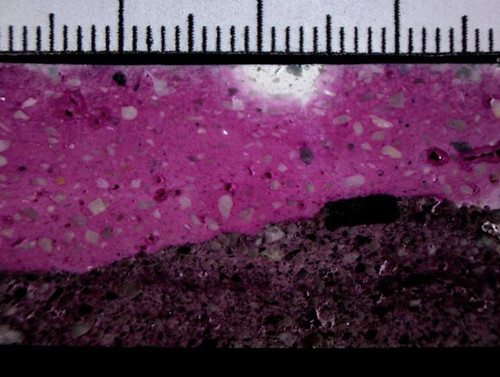The following information provides pictures and scientific evidence from the cement petrographers who performed “failure analysis” examinations on white spotted pool plaster cores.

The first picture (above) is of a plaster core from the pool that had suffered from white spotting. Note the six major white spots, and also note the general and overall “graying” (off-white) of the plaster surrounding the white spots. When submerged in water, the gray (or grey) color becomes slightly darker. The addition of calcium chloride to a plaster mix contributes to graying of white cement.

The second picture is of a cross-section of one of the spots on the core magnified. The Scale on top of that picture is marked in “millimeter” increments.
The polished side section of the plaster coupon was treated with a solution (phenolphthalein) that imparts a purple-red stain to high pH, non-carbonated cement paste, but also leaves a faint pink to no color stain on reduced pH, carbonated paste.
Note the non-colored (white) spot at the top surface of the plaster coupon. That spot corresponds to one of the white spots in the first picture above.
The dark purple-black colored layer at bottom of second picture is of the gunite (substrate) of this in-ground swimming pool which was removed during the coring (drilling) process.

The third picture is a close-up of the white spot. Question: Does the plaster surface on these cross-sectioned pictures appear to be etched by aggressive water? No, the surface is very smooth considering the magnification of these photos. Under closer and more detailed examination, the entire white area was determined to be porous, soft, and carbonated (by balanced pool water).

The fourth picture below involves Scanning Electron Microscopy (SEM) and includes two Backscattered Electron (BSE) images. The image on top left in taken at 100X magnification, and the one on top right is taken at 250X magnification. The darker gray plaster paste on top portion of each image is porous and soft. The lighter colored gray plaster paste towards bottom area is denser, harder, and has not been carbonated. Note the whitish dense carbonated layer at center.
The bottom portion of the above image is an Energy-dispersive X-ray spectroscopy (EDS) determining the major cement elements in a specific area.
All four cement labs analyzed a different plaster core and determined that all contained more than three (3) percent calcium chloride. (Two percent is the maximum allowable).
The white spots were caused by improper plastering practices, not by aggressive water chemistry.
For more information, see the following post: white-spotting-of-new-plaster-pools-t56607.html
For proper plastering practices, see the following post: ten-guidelines-for-quality-pool-plaster-t42957.html

The first picture (above) is of a plaster core from the pool that had suffered from white spotting. Note the six major white spots, and also note the general and overall “graying” (off-white) of the plaster surrounding the white spots. When submerged in water, the gray (or grey) color becomes slightly darker. The addition of calcium chloride to a plaster mix contributes to graying of white cement.

The second picture is of a cross-section of one of the spots on the core magnified. The Scale on top of that picture is marked in “millimeter” increments.
The polished side section of the plaster coupon was treated with a solution (phenolphthalein) that imparts a purple-red stain to high pH, non-carbonated cement paste, but also leaves a faint pink to no color stain on reduced pH, carbonated paste.
Note the non-colored (white) spot at the top surface of the plaster coupon. That spot corresponds to one of the white spots in the first picture above.
The dark purple-black colored layer at bottom of second picture is of the gunite (substrate) of this in-ground swimming pool which was removed during the coring (drilling) process.

The third picture is a close-up of the white spot. Question: Does the plaster surface on these cross-sectioned pictures appear to be etched by aggressive water? No, the surface is very smooth considering the magnification of these photos. Under closer and more detailed examination, the entire white area was determined to be porous, soft, and carbonated (by balanced pool water).

The fourth picture below involves Scanning Electron Microscopy (SEM) and includes two Backscattered Electron (BSE) images. The image on top left in taken at 100X magnification, and the one on top right is taken at 250X magnification. The darker gray plaster paste on top portion of each image is porous and soft. The lighter colored gray plaster paste towards bottom area is denser, harder, and has not been carbonated. Note the whitish dense carbonated layer at center.
The bottom portion of the above image is an Energy-dispersive X-ray spectroscopy (EDS) determining the major cement elements in a specific area.
All four cement labs analyzed a different plaster core and determined that all contained more than three (3) percent calcium chloride. (Two percent is the maximum allowable).
The white spots were caused by improper plastering practices, not by aggressive water chemistry.
For more information, see the following post: white-spotting-of-new-plaster-pools-t56607.html
For proper plastering practices, see the following post: ten-guidelines-for-quality-pool-plaster-t42957.html

